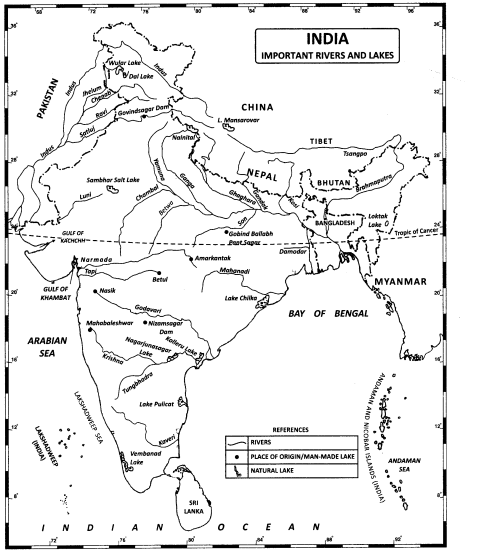Class 11 Geography NCERT Solutions Chapter 3 Drainage System
False______________________________________________________________________________________________________________
1. Choose the right answer from the four alternatives given below: 1. Choose the right answer from the four alternatives given below: 1. Choose the right answer from the four alternatives given below: 1. Choose the right answer from the four alternatives given below: 1. Choose the right answer from the four alternatives given below: 2. Choose the right answer from the four alternatives given below: 3. Choose the right answer from the four alternatives given below: 4. Choose the right answer from the four alternatives given below: 3. Choose the right answer from the four alternatives given below: 4. Choose the right answer
Question 1(i).
Which one of the following rivers was known as the ‘Sorrow of Bengal’?
(a) The Gandak
(b) The Son
(c) The Kosi
(d) The Damodar
Answer:
(d) The Damodar
Question 1(ii).
Which one of the following rivers has the largest river basin in India?
(a) The Indus
(b) The Brahmaputra
(c) The Ganga
(d) The Krishna
Answer:
(c) The Ganga
Question 1(iii).
Which one of the following rivers is not included in ‘Panchnad’?
(a) The Ravi
(b) The Chenab
(c) The Indus
(d) The Jhelum
Answer:
(c) The Indus
Question 1(iv).
Which one of the following rivers flows in a rift valley?
(a) The Son
(b) The Narmada
(c) The Yamuna
(d) The Luni
Answer:
(b) The Narmada
Question 1(v).
Which one of the following is the place of confluence of the Alaknanda and the Bhagirathi?
(a) Vishnu Prayag
(b) Rudra Prayag
(c) Karan Prayag
(d) Deva Prayag
Answer:
(d) Deva Prayag
False
Question 2(i).
River Basin and Watershed
Answer:
| River Basin | Basis | Watershed |
| The catchments of large rivers are called river basins. | Meaning | Catchment of small rivulets and rills are often referred to as watersheds. |
| Rivers basins are larger in area. | Area | Watersheds are smaller in area. |
Question 2(ii).
Dendritic and Trellis drainage pattern
Answer:
| Dendritic drainage pattern | Basis | Trellis drainage pattern |
|
Dendritic drainage system is a drainage pattern resembling the branches of a tree is known as “dendritic”.
: False |
Meaning |
When the primary tributaries of rivers flow parallel to each other and secondary tributaries join them at right angles, the pattern is known as ‘trellis’.
True |
Question 2(iii).
Radial and Centripetal drainage pattern
Answer:
| Radial drainage pattern | Basis | Centripetal drainage pattern |
|
When the rivers originate from a hill and flow in all directions, the drainage pattern is known as ‘radial’.
positive |
Meaning |
When the rivers discharge their waters from all directions in a lake or depression, the pattern is known as ‘centripetal’.
|
Question 2(iv).
Delta and Estuary
Answer:
| Delta | Basis | Estuary |
| Delta is a triangular land mass formed by depositional alluvium at the mouth of river. | Shape | Estuary is the sunken mouth of the river where the rivers meets the sea forming the tunnel shaped zone where saline and fresh water mix. |
| They are formed on the tideless sea coast near the mouth of river where sediment brought by the rivers is deposited. | Formation | They are result of strong currents and hightides at the mouth of river where no deposition takes place. |
| They are rich agriculture ground. | Suitability | They are rich fishing ground and are suitable for inland transportation. |
| Rivers like Krishna, Kaveri, Mahanadi, Godavari form deltas. | Rivers | Narmada and Tapi forms estuaries. |
True
Question 3(i).
What are the socio-economic advantages of inter-linking of rivers in India?
Answer:
Indian rivers are of two types: perennial rivers in which there is water through out the year and peninsular rivers in which water is there in rainy seasons only. Rivers of India bear a large amount of water every year. But its distribution is not equal from the point of view of time and place. Most of the water gets wasted in floods during rainy seasons. It also causes loss of life and property. It ruins agriculture as well. At other places, there is situation of drought.
True
Question 3(ii).
Write three characteristics of the Peninsular rivers.
Answer:
These rivers originate in peninsular plateau and central highland. These are seasonal as it is dependent on monsoon rainfall. They reflect super imposed type of drainage pattern and rejuvenated resulting in trellis, radial and rectangular patterns. These rivers are smaller having fixed course with well-adjusted valleys. Their catchment area is relatively smaller basin. These rivers are old rivers with graded profile, and have almost reached their base levels.
True
Question 4(i).
What are the important characteristic features of north Indian rivers? How are these different from Peninsular rivers?
Answer:
Important characteristics of north Indian rivers are as follows:
- Origin: They originate in Himalayan mountain covered with glaciers.
- Nature of flow: These are perennial because they receive water from glacier and rainfall.
- Drainage pattern: These’ are antecedent and consequently lead to dendritic pattern in plains.
- Nature of river: It has long course, flowing through the rugged mountains experiencing headward erosion and river capturing; In plains it exhibits meandering and shifting of course.
- Catchment area: Its catchment areas include very large basins.
- Age of river: These rivers are young and youthful. These are active and deepening in the valleys.
False
- Place of origin: Peninsular plateau and central highland.
- Nature of flow: Seasonal as it is dependent on monsoon rainfall.
- Type of drainage: Super imposed, rejuvenated resulting in trellis, radial and rectangular patterns.
- Nature of river: Smaller, fixed course with well-adjusted valleys.
- Catchment area: Relatively smaller basin.
- Age of the river: Old rivers with graded profile, and have almost reached their base levels.
Question 4(ii).
Suppose you are travelling from Haridwar to Siliguri along the foothills of the Himalayas. Name the important rivers you will come across. Describe the characteristics of any one of them.
Answer:
While travelling from Haridwar to Siliguri along the foothills of the
Himalayas, we shall come across Tons, Gomti, Saryu, Ramganga, Sharda, Gandak, Old Gandak, Kamla, Bagmati, Kosi and Ganga.
True
True
True
Paraphrase: Project/Aactivity: Project/Aactivity: Project/Aactivity: Project/Aactivity: Project/Aactivity: Project/Aactivity: Project/Aactivity: Project/Aactivity: Project/Aactivity: Project/Aactivity: Project/Aactivity: Project/Aactivity: Project/Aactivity: Project/Aactivity: Project/Aactivity: Project/Aactivity: Project/Aactivity: Project/Aactivity: Project/Aactivity: Project/Aactivity: Project/Aactivity: Project/Aactivity:
True
(i) Which river has the largest proportion of catchment area in the country?
Answer:
Attempt yourself.
(ii) Make a comparative bar diagram on a graph paper to show the length of the courses of the rivers.
Answer:
Attempt yourself.
Fake: Class 11 Geography Chapter 3 NCERT Extra Questions NCERT Extra Questions NCERT Extra Questions NCERT Extra Questions NCERT Extra Questions NCERT Extra Questions NCERT Extra Questions NCERT Extra Questions NCERT Extra Questions NCERT Extra Questions NCERT Extra Questions NCERT Extra Questions NCERT Extra Questions NCERT Extra Questions NCERT Extra Questions NCERT Extra Questions NCERT Extra Questions NCERT Extra Questions NCERT Extra Questions NCERT Extra Questions NCERT Extra Questions NCERT Extra Questions NCERT Extra Questions NCERT Extra Questions NCERT Extra Questions
Falsifizieren Sie: Falsifizieren Sie: Falsifizieren Sie: Falsifizieren Sie: Falsifizieren Sie: Falsifizieren Sie: Falsifizieren Sie: Falsifizieren Sie: Falsifizieren Sie: Falsifizieren Sie: Falsifizieren Sie: Falsifizieren Sie: Falsifizieren Sie: Falsifizieren Sie: Falsifizieren
Question 1.
The pattern of flow of water in a river channel over a year is known as what?
(a) Regime
(b) Cumecs
(c) Cusecs
(d) None of these
Answer:
(a) Regime
Question 2.
Cumecs is measured:
(a) Cubic foot per second
(b) Cubic metres per second
(c) In square metres
(d) None of these
Answer:
(b) Cubic metres per second
Question 3.
When the shape of drainage system resembles branches of a tree, it is called:
(a) Dendritic drainage system
(b) Radial drainage system
(c) Trellis
(d) Centripetal Drainage System
Answer:
(a) Dendritic drainage system
Question 4.
The path on which the river flows along is called:
(a) River course
(b) River flow
(c) River channel
(d) Watershed
Answer:
(a) River course
Question 5.
Which of the following river falls into Arabian Sea?
(a) Mahanadi
(b) Krishna
(c) Narmada
(d) Kaveri
Answer:
(c) Narmada
Question 6.
Which of the following is the largest river of peninsular India?
(a) Mahanadi
(b) Krishna
(c) Godavari
(d) Sabarmati
Answer:
(c) Godavari
Question 7.
Which of the following rivers forms a delta?
(a) Narmada
(b) Tapti
(c) Sabarmati
(d) Krishna
Answer:
(d) Krishna
Question 8.
Which of the following river is called Dakshin Ganga?
(a) Mahanadi
(b) Krishna
(c) Godavari
(d) Sabarmati
Answer:
(c) Godavari
Question 9.
Name the westernmost and longest tributary of river Ganga?
(a) Kosi
(b) Ramganga
(c) Gandak
(d) Yamuna
Answer:
(d) Yamuna
Question 10.
By which name is river Brahmaputra known in Tibet?
(a) Dihang
(b) Dibang
(c) Shansi
(d) Sangpo
Answer:
(d) Sangpo
Question 11.
Which river has formed Sunderban delta?
(a) Ganga
(b) Krishna
(c) Godavari
(d) Sabarmati
Answer:
(a) Ganga
Question 12.
From where does river Chenab originate?
(a) Baralacha Pass
(b) Rohtang Pass
(c) Rakstal
(d) Verinag
Answer:
(a) Baralacha Pass
Falsifizieren Sie: Falsifizieren Sie: Falsifizieren Sie: Falsifizieren Sie: Falsifizieren Sie: Falsifizieren Sie: Falsifizieren Sie: Falsifizieren Sie: Falsifizieren Sie: Falsifizieren Sie: Falsifizieren Sie: Falsifizieren Sie: Falsifizieren Sie: Falsifizieren Sie: Falsifizieren
Question 1.
On the basis of origin, form and features in how many groups can we classify rivers of India?
Answer:
On the basis of origin, form and features, we can classify the rivers of India into four parts:
- Himalayan Rivers;
- Peninsular rivers;
- Coastal Rivers and
- Internal basin rivers.
Question 2.
By which names is river Brahmaputra known?
Answer:
In Tibet, it is called Tsangpo. It emerges as a turbulent and dynamic river after carving out a deep gorge in the Central Himalayas near Namcha Barwa (7,755 m). The river emerges from the foothills under the name of Siang or Dihang. In India, it is called Brahmaputra. In Bangladesh, it is known as the Yamuna. It finally merges with the river Padma, which falls in the Bay of Bengal.
Question 3.
Name important tributaries of Brahmaputra river system.
Answer:
Important tributaries of Brahmaputra river system are the Burhi Dining, Dhansari (South), Subansiri, Kameng, Manas and Sankosh.
Question 4.
Define drainage system.
Answer:
The flow of water through well-defined channels is known as ‘drainage’ and the network of such channels is called a ‘drainage system’. The drainage pattern of an area is the outcome of the geological time period, nature and structure of rocks, topography, slope, amount of water flowing and the periodicity of the flow.
Question 5.
What are different forms of drainage system?
Answer:
The different drainage patterns are “dendritic”; ‘radial’; ‘trellis’ and ‘centripetal’.
Question 6.
In how many parts is Indo-Brahma drainage system dismembered?
Answer:
It is opined that in due course of time Indo-Brahma river was dismembered into three main drainage systems:
- The Indus and its five tributaries in the western part;
- The Ganga and its Himalayan tributaries in the central part;
- The stretch of the Brahmaputra in Assam and its Himalayan tributaries in the eastern part.
Question 7.
Name the longest river of Kerala. From where does it originate?
Answer:
The longest river of Kerala is Bharatpuzha. It originates from Annamalai hills. It is also known as Pongnani. It covers approximately 5397 km of area.
Question 8.
What type of drainage system is there in Thar Desert?
Answer:
Drainage system in Thar Desert is of centripetal type.
Question 9.
Name the rivers which fall in Bay of Bengal.
Answer:
Important rivers falling in Bay of Bengal include Ganga, Mahanadi, Godavari, Krishna and Kaveri.
Question 10.
Name the rivers which fall into Arabian Sea.
Answer:
Indus and its tributaries, Narmada, Tapti, Sabarmati rivers fall into Arabian Sea.
Question 11.
What is watershed?
Answer:
The boundary line separating one drainage basin from the other is known as watershed.
Question 12.
Name the factors on which the drainage pattern depends?
Answer:
The drainage pattern of an area is the outcome of the geological time period, nature and structure of rocks, topography, slope, amount of water flowing and the periodicity of the flow.
False______________________________________________________________________________________________________________
Question 1.
Explain about flood prone areas of India.
Answer:
The states falling within the periphery of “India Flood Prone Areas” are West Bengal, Orissa, Andhra Pradesh, Kerala, Assam, Bihar, Gujarat, Uttar Pradesh, Haryana and Punjab. The intense monsoon rains from south-west causes rivers like Brahmaputra, Ganga, Yamuna etc. to swell their banks, which in turn floods the adjacent areas.
Over the past few decades, Central India has become familiar with precipitation events like torrential rains and flash floods. The major flood prone areas in India are the river banks and deltas of Ravi, Yamuna-Sahibi, Gandak, Sutlej, Ganga, Ghaggar, Kosi, Teesta, Brahmaputra, Mahanadi, Mahananda, Damodar, Godavari, Mayurakshi, Sabarmati and their tributaries. During the rainy season, much of the water is wasted in floods and flows down to the sea. Similarly, when there is a flood in one part of the country, the other area suffers from drought. The Godavari is subjected to heavy floods in its lower reaches to the south of Polavaram, where it forms a picturesque gorge.
Question 2. Explain important features of Kaveri Basin.
Answer:
Important features of Kaveri Basin are as follows:
- The Kaveri rises in Brahmagiri hills (1,341m) of Kogadu district in Karnataka.
- Its length is 800 km and it drains an area of 81,155 sq. km.
- Since the upper catchment area receives rainfall during the southwest monsoon season (summer) and the lower part during the northeast monsoon season (winter), the river carries water throughout the year with comparatively less fluctuation than the other Peninsular rivers.
- About 3 per cent of the Kaveri basin falls in Kerala, 41 per cent in Karnataka and 56 per cent in Tamil Nadu.
- Its important tributaries are the Kabini, the Bhavani and the Amravati. The Narmada originates on the western flank of the Amarkantak plateau at a height of about 1,057 m.
Question 3.
Differentiate between the features of Ganga river and Jhelum river.
Answer:
The Ganga is the most important river of India both from the point of view of its basin and cultural significance. It rises in the Gangotri glacier near Gaumukh (3,900 m) in the Uttarkashi district of Uttarakhand. Here, it is known as the Bhagirathi. It cuts through the Central and the Lesser Himalayas in narrow gorges. The important left bank tributaries are the Ramganga, the Gomati, the Ghaghara, the Gandak, the Kosi and the Mahananda. The river finally discharges itself into the Bay of Bengal near the Sagar Island. The Jhelum, an important tributary of the Indus, rises from a spring at Verinag situated at the foot of the Pir Panjal in the south-eastern part of the valley of Kashmir. It flows through Srinagar and the Wular lake before entering Pakistan through a deep narrow gorge. It joins the Chenab near Jhang in Pakistan.
Question 4.
The two Peninsular rivers display interesting differences in their regimes compared to the Himalayan rivers. Explain.
Answer:
The two Peninsular rivers display interesting differences in their regimes compared to the Himalayan rivers. The Narmada has a very low volume of discharge from January to July but it suddenly rises in August when the maximum flow is attained. The fall in October is as spectacular as the rise in August. The flow of water in the Narmada, as recorded at Garudeshwar, shows that the maximum flow is of the order of2,300 cusecs, while the minimum flow is only 15 cusecs. The Godavari has the minimum discharge in May, and the maximum in July-August. After August, there is a sharp fall in water flow although the volume of flow in October and November is higher than that in any of the months from January to May. The mean maximum discharge of the Godavari at Polavaram is 3,200 cusecs while the mean minimum flow is only 50 cusecs.
Question 5.
Flow of Ganga is not same throughout the year. Explain.
Answer:
The Ganga has its minimum flow during the January-June period. The maximum flow is attained either in August or in September. After September, there is a steady fall in the flow. The river, thus, has a monsoon regime during the rainy season. There are striking differences in the river regimes in the eastern and the western parts of the Ganga Basin. The Ganga maintains a sizeable flow in the early part of summer due to snow melt before the monsoon rains begin. The mean maximum discharge of the Ganga at Farakka is about 55,000 cusecs while the mean minimum is only 1,300 cusecs.
False______________________________________________________________________________________________________________
Question 1.
How are rivers of India useful for India?
Answer:
Rivers are useful for us because:
- Water: Rivers carry water and nutrients to areas all around the earth. They play a very important part in the water cycle, acting as drainage channels for surface water. Rivers drain nearly 75% of the earth’s land surface.
- Habitats: Rivers provide excellent habitat and food for many of the earth’s organisms. Many rare plants and trees grow by rivers. Ducks, voles, otters and beavers make their homes on the river banks. Reeds and other plants like bulrushes grow along the river banks. Other animals use the river for food and drink. Birds such as kingfishers eat small fish from the river.
- Delta: River deltas have many different species of wildlife. Insects, mammals and birds use the delta for their homes and for food.
- Transport: Rivers provide travel routes for exploration, commerce and recreation.
Question 2.
Explain about Indus River System.
Answer:
The Indus System
- It is one of the largest river basins of the world, covering an area of 11,65,000 sq. km (in India it is 321, 289 sq. km) and a total length of 2,880 km (in India 1,114 km). The Indus also known as the Sindhu, is the westernmost of the Himalayan rivers in India.
- It originates from a glacier near Bokhar Chu (31°15′ N latitude and 81°40′ E longitude) in the Tibetan region at an altitude of 4,164 m in the Kailash mountain range.
- The Indus receives a number of Himalayan tributaries such as the Shyok, the Gilgit, the Zaskar, the Hunza, the Nubra, the Shigar, the Gasting and the Dras. It finally emerges out of the hills near Attock where it receives the Kabul river on its right bank. The other important tributaries joining the right bank of the Indus are the Khurram, the Tochi, the Gomal, the Viboa and the Sangar.
- They all originate in the Sulaiman ranges. The river flows southward and receives ‘Panjnad’ a little above Mithankot. The Panjnad is the name given to the five rivers of Punjab, namely the Satluj, the Beas, the Ravi, the Chenab and the Jhelum.
- It finally discharges into the Arabian Sea, east of Karachi.
- The Indus flows in India only through the Leh district in Jammu and Kashmir.
Question 3.
Explain about Ganga River System.
Answer: The Ganga System:
1. The Ganga is the most important river of India both from the point of view of its basin and cultural significance. It rises in the Gangotri glacier near Gaumukh (3,900 m) in the Uttarkashi district of Uttarakhand. Here, it is known as the Bhagirathi. It cuts through the Central
and the Lesser Himalayas in narrow gorges.
False
False
False
False
False
Question 4.
What factors determine volume of water in a river?
Answer:
Factors affecting the volume of water in a river:
False
2.Vegetation is also an important factor. Leaves of tress intercept rainwater and allow more water to sweep into the ground in groundwater. As a result, the amount of surface runoff reduces. Therefore, the volume of water in the river is less where vegetation is dense. Spare vegetation prevents rainwater from getting trapped in the leaves and
branches, thereby allowing more water to flow through as surface runoff. So, in areas with less vegetation volume of water is more.
True
False
Question 5.
Explain the different drainage patterns formed by rivers. Draw diagram of each drainage pattern with two examples of each.
Answer:
The drainage pattern formed by rivers are:
(a) Dendritic:
The drainage resembling, the branches of a tree is known as ‘dendritic’ the examples of which are the rivers of northern plains like Ganga, Yamuna, etc.
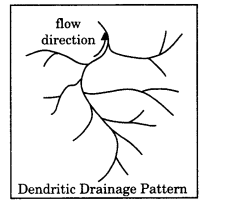
(b) Radial: When the rivers originate from a hill and flow in all directions, the drainage pattern is known as ‘radial’ or the dome-shaped pattern. The river originating from the Amarkanta range and central highlands present a good example of it.
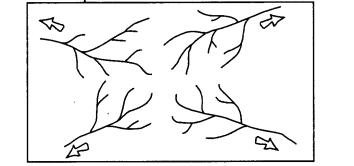
(c) Trellis: When the primary tributaries of rivers flow parallel to each and secondary tributaries join them at right angles, the pattern is known as ‘trellis’ e.g. Peninsular river such as Godavari, Krishna etc.
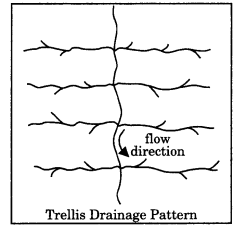
(d)Centripetal: When the rivers discharge their waters from all directions in a lake or in depressions, it is known as ‘centrifugal’. These rivers form cascades/rapids and waterfalls.
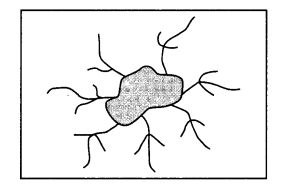
Question 6.
Differentiate between:
(a) Himalayas rivers and the Peninsular rivers.
Answer:
Difference between Himalayas Rivers and the Peninsular rivers.
| Aspects | Himalayan rivers | Peninsular rivers |
| Place of origin | Himalayan mountains covered with glaciers | Peninsular plateau and central highland |
| Nature of flow | Perennial; receive water from glacier and rainfall | Seasonal, dependent on monsoon rainfall |
| Type of drainage | Antecedent and consequent leading to dendritic pattern in plains. | Super imposed : rejuvenated resulting in trellis and rectangular pattern |
| Nature of river | Long course, flowing through the mountains. Experiencing headwater erosion and river capturing in plains meandering and shifting of course. | Smaller, fixed course with well adjusted valleys. |
| Catchment area | Very large basins | Relatively smaller basin |
| Area of river | Young and youthful, active and deepening of the valleys. | Old rivers with graded profile, and have almost reached their base levels |
| Examples | Indus, Ganges and Brahmaputra and their tributaries. | Peninsular Plateau Chambal, Betwa, Central Highlands, Godavari, Krishna, etc. |
(b) Consequent rivers and Antecedent rivers
Answer:
Difference between Consequent rivers and Antecedent rivers
| Basis | Consequent rivers | Antecedent rivers |
| Shape | These rivers maintain their original shapes, deposits, the rise of land due to folding. The rivers keep on following in the same direction. | It is an uplift area the rivers flow in the direction resulting as consequent of the slope |
| Age | These rivers are older than the old mountain. | These rivers are formed after the uplift of an area. |
:
| Gorges | These rivers cut deep gorges due to down cutting. | These rivers do not form gorges. |
| Examples | Trans- Himalayan rivers such as Indus, Satluj, represent consequent rivers. | The eastward flowing river of peninsular plateau which flow according to the slope are antecedent rivers. |
Question 7.
Differentiate between canyon, gorge and river valley.
Answer:
A canyon is a deep valley with steep sides, think of the grand canyon most famously to visualise what this is. A gorge is a deep ravine, which usually has a river running through it—though this doesn’t have to be the case. Finally a valley is any depression, usually of a certain length, in the surface of the land and often contains a river. So, a canyon is a specific type of valley, with particularly steep sides. A gorge is a particularly deep depression, and will usually contain a river.
Questions: Class 11 Geography Chapter 3 HOTS Questions: Class 11 Geography Chapter 3 HOTS Questions: Class 11 Geography Chapter 3 HOTS Questions: Class 11 Geography Chapter 3 HOTS Questions: Class 11 Geography Chapter 3 HOTS Questions: Class 11 Geography Chapter 3 HOTS Questions: Class 11 Geography Chapter 3 HOTS Questions: Class 11 Geography Chapter 3 HOTS Questions: Class 11 Geography Chapter 3 HOTS Questions: Class 11 Geography Chapter 3 HOTS Questions: Class 11 Geography Chapter 3 HOTS Questions:
Question 1.
What makes a river system? Explain its components.
Answer:
River system
- A river is a body of water, which flows into channel from a higher elevations to a lower elevation rivers usually originate from lake or melting snow on top of mountains flow down hill and join sea or ocean. The place from where the river originates is known as the source, and where it ends is known as the mouth.
- From the source , the river flows along a path which is known as its course. The course of a river can be divided into three parts, the upper course, the middle course and the lower course.
- In the upper course, the river flows with great force through a narrow and shallow channel. Only a small amount of water is transported. The gradient slope of river is very steep.
- In the middle course, the force of the river reduces its flow through gentle gradient such as plains. Many small stream or river join the main river in the middle course resulting in widening of the river channel. The small streams are known as tributaries.
- The river finally flows into lake, sea or ocean. The part of the river that enters the sea is known as the river mouth.
- A river and its tributaries together form a drainage basin. A drainage basin is an area obtained by two main river and its tributaries and drainage basin is separated from adjacent basins by a hill, a ridge or mountain which is known as a drainage divide or watershed.
Question 2.
What factors affect speed of a river?
Answer:
Factors affecting the speed of a river: The main factor affecting the speed of a river are the gradient and roughness of the channel and the wetled perimeter gradient.
False
False
False
Question 3.
Explain the evolution of Himalayan river system.
Answer:
There are difference of opinion about the evolution of the Himalayan river system. However, geologists believe that a mighty river called Shiwalik or Indo-Brahma traversed the entire longitudinal extent of the Himalaya from Assam to Punjab and onwards to Sind, and finally discharged into the Gulf of Sind near lower Punjab during the Miocene period some 5-24 million years ago. The remarkable continuity of the Shiwalik and its lacustrine origin and alluvial deposits consisting of sands, silt, clay, boulders and conglomerates support this viewpoint.
False
Question 4.
Explain the evolution of Peninsular drainage system
Answer:
Three major, geological events in the distant past have shaped the present drainage systems of Peninsular India:
- Subsidence of the western flank of the Peninsula leading to its submergence below the sea during the early tertiary period. Generally, it has disturbed the symmetrical plan of the river on either side of the original watershed.
- Upheaval of the Himalayas when the northern flank of the Peninsular block was subjected to subsidence and the consequent trough faulting.
- Slight tilting of the Peninsular block from north-west to the south-eastern direction gave orientation to the entire drainage system towards the Bay of Bengal during the same period.
False
Question 1.
What are the problems associated with the use of river water?
Answer:
There are some problems in river water usage. Some of these are:
- No availability in sufficient quantity
- River water pollution
- Load of silt in the river water
- Uneven seasonal flow of water
- River water disputes between states
- Shrinking of channels due to the extension of settlements towards the thalweg.
Question 2.
What are the causes of pollution of river water?
Answer:
Major causes of pollution of river water:
- Growing Population,
- Poverty,
- Urbanization,
- Industrialization,
- Agricultural run-off and Improper Agricultural Practices, and
- Religious and Social Practices.
Question 3.
What measures do you suggest to reduce pollution of rivers?
Answer:
River pollution generally originates from industrial effluents, agricultural run-off and domestic sewage, which is resulting in environmental-economic loss to the country. Rapid industrialization and urbanization, accompanied by rural exodus to urban areas have had their evil consequences, generally on environment, and particularly on rivers. The law dealing with the task of prevention and control of river pollution, is needed to be set in motion along with public awareness about the importance of pollution free rivers, so that the rivers can be saved from the curse of pollution, and the precious money of the Government exchequer can be saved from expenditure on the river cleaning programmes.
Question 4.
Can the problems of flood and drought be solved or minimised by transferring the surplus water from one basin to the water deficit basins? Do we have some schemes of inter-basin linkage?
Answer:
Yes, these problems be solved or minimised by transferring the surplus water from one basin to the water deficit basins. During the rainy season, much of the water is wasted in floods and flows down to the sea. When there is a flood in one part of the country, the other area suffers from drought. We do have such schemes:
- Periyar Diversion Scheme
- Indira Gandhi Canal Project
- Kurnool-Cuddapah Canal
- Beas-Satluj Link Canal
- Ganga-Kaveri Link Canal
Map Skill
Question 1.
Locate on the physical map of India, important rivers of India.
Answer:
